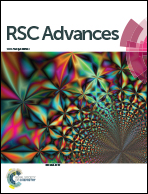Assembly of neutral conjugated polymers with layered double hydroxide nanosheets by the layer-by-layer method†
Abstract
Layer-by-layer (LbL) assembly is a simple and prevalent method for constructing functional multilayer thin films with charged components and is usually based on electrostatic interactions. This article reports neutral conjugated polymers (NCPs) that can also be assembled with exfoliated MgAl-layered double hydroxide (LDH) nanosheets to form the ordered inorganic/organic hybrid ultrathin films (UTFs) via the LbL assembly technique. Furthermore, neutral small molecules such as PCBM could also be co-assembled with LDH nanosheets by being encapsulated into the NCPs during the LbL process. These composite UTFs were characterized thoroughly and were found to have an ordered periodic structure along the film normal with a 7.6–13.6 nm thickness of the interlayer space, the assembled bilayers numbers could be up to 40, and the interlayer polarity was transfered to hydrophobic ones, which facilitated the assembly of some organic functional molecules. The driving force for this assembly is discussed and attributed to the interactions between the positive charge of LDH nanosheets and the delocalized π electrons of these NCPs. Moreover, the (NCPs/LDH)n UTFs could detect some small biological medicine molecules such as protoporphyrin, which has the potential to be a novel type of biological fluorescence sensor material.


 Please wait while we load your content...
Please wait while we load your content...